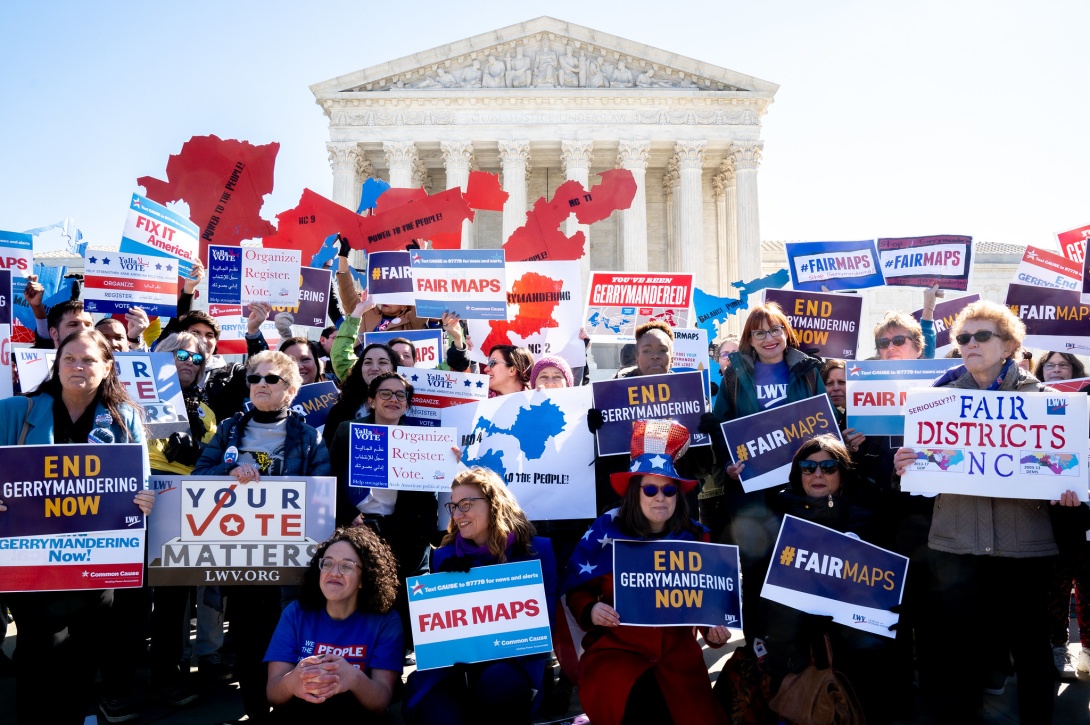New GOP congressional maps diminish the power of voters of color

A rally to end gerrymandering was held outside the U.S. Supreme Court in 2019 as justices heard a case from North Carolina, where voting rights advocates once again are threatening to sue over new voting maps that fail to take race into consideration. (Photo by Victoria Pickering via Flickr.)
(This story was corrected at 5 p.m. on Oct. 29 to note that the former Virginia congressman who sought map-drawing aid from the National Republican Redistricting Trust is not a member of the independent redistricting commission. It was also updated at that time with the breaking news of a lawsuit filed over North Carolina's new maps by the Southern Coalition for Social Justice.)
The process of redistricting got underway this fall on a shortened timeline due to census delays caused by the coronavirus pandemic, and Republican-controlled legislatures in the South — a region with a history of racial gerrymandering — have already started drawing maps in their favor that fail to reflect demographic changes that have taken place over the last decade.
The stakes are especially high this cycle: For the first time, redistricting will occur without the federal preclearance that was required for states with a history of racial discrimination in elections under the Voting Rights Act of 1965, which was gutted by the United States Supreme Court in its landmark 2013 Shelby County v. Holder ruling out of Alabama.
Despite census results that show a growing multiracial population, some Southern state legislatures led by Republicans have already sought to diminish the power of voters of color. This week, for instance, Texas Gov. Greg Abbott (R) approved new voting maps drawn by the GOP-controlled legislature that give Republicans a major advantage while failing to reflect that 95% of the state's population growth over the past decade was in communities of color. The state gained nearly 11 Hispanic residents for every additional white resident, and Hispanics now make up 39.26% of the state's population compared to 39.75% for whites, the Texas Tribune reported.
The battle over Texas redistricting now heads to the courts, where a prominent Latino legal advocacy group brought a lawsuit challenging the fairness of the new maps even before Abbott signed them into law.
The Mexican American Legal Defense and Educational Fund filed a lawsuit on Oct. 18 in the U.S. District Court for the Western District of Texas, El Paso Division, on behalf of over a dozen individual and organizational plaintiffs in the state. The suits says the state's redistricting plan violates the 14th Amendment to the U.S. Constitution and Section Two of the Voting Rights Act, both of which bar racial discrimination.
"Despite having only recently been found liable by a federal court for intentional racial discrimination in redistricting, Texas has once again adopted plans that dilute Latino voting strength," Nina Perales, MALDEF's vice president of litigation, said in a press release. "The new redistricting plans are an unlawful attempt to thwart the changing Texas electorate and should be struck down."
The complaint notes that the courts found the state's 2011 voting maps to be discriminatory against people of color and redrew them; they remained in litigation until 2019. As the state with the most population growth over the past decade, Texas gained two congressional seats, but those new districts were not drawn to reflect the state's new demographic reality, according to MALDEF.
Instead, Texas lawmakers reduced the number of districts where Hispanics make up the majority of the population from eight to seven, while the number of districts where Black people are a majority decreased from one to none, according to a Texas Tribune analysis. Texas lawmakers have said they chose not to look at racial data when determining new congressional and legislative districts.
The Princeton Gerrymandering Project, an organization that provides nonpartisan analysis of redistricting maps, gave the new Texas congressional maps a C in competitiveness and F's in partisan fairness and geographic features, which evaluate compactness and the number of split counties.
Its grading system is based on an algorithm that generates about one million unique maps for each legislative chamber, according to Helen Brewer, a legal analyst for the project. "The Texas congressional map received an F in partisan fairness because it produced a significant Republican advantage, making it an outlier that would yield more Republican seats than most maps generated in the ensemble that were drawn to meet fairness standards," Brewer explained in an email.
More redistricting lawsuits likely
Arkansas and Texas were the first states in the South to finish redistricting this year, and the process is also moving along in North Carolina. The Princeton Gerrymandering Project gave the latest congressional maps released by North Carolina lawmakers an A for partisan advantage and C's for competitiveness and geographic features.
"If fairness is proportionality to statewide results, you're not going to get that, because the dynamic of our election system automatically skews to the party that wins congressional seats," Michael Bitzer, a politics and history professor at Catawba College in Salisbury, North Carolina, told Facing South. "For what folks are looking at with these maps, do the Republicans push the envelope to garner as many seats as possible? I think that that's probably going to be the crucial test when it comes to these maps."
North Carolina gained one additional congressional seat because of population growth, and the Republicans in charge of redistricting centered it around mostly rural Cleveland County — even though most of the state's population growth occurred in urban Mecklenburg and Wake counties. The state's current proposed congressional redistricting plan gives Republicans a likely 11-3 or 10-4 advantage.
"Whenever you add a congressional seat to a state, the most political activity in America, which is redistricting, gets even more political. I think the dynamic of what most folks are expecting is that that 14th seat would go to benefit a current legislator in the General Assembly," Bitzer said. "All eyes are looking to Tim Moore, the speaker of the House, whose current district is in Cleveland County."
Like their counterparts in Texas, Republican legislators in North Carolina chose not to consider racial data in redistricting, a controversial move given both states' fraught history of drawing maps that courts have deemed racially discriminatory. Allison Riggs, a voting rights attorney with the Southern Coalition for Social Justice, which has led the fight against discriminatory maps in the state, has already warned that "race-blind" redistricting is not legal and threatened to sue. (Her organization announced a lawsuit on Oct. 29, saying that the state's redistricting process "largely ignored input, misled the public, and brazenly ignored the duty to draw districts that don't dilute Black voices.")
In Arkansas, the new election maps became law on Oct. 13 without the approval of Gov. Asa Hutchinson (R), who chose not to sign the redistricting bills. He criticized the new maps' effect on communities of color.
"While the percentage of the minority composition of the proposed map for three of the four districts does not differ much from the current percentages, the removal of minority areas in Pulaski County into two different districts raises concerns," said Hutchinson, who served as counsel in a 1990 case with the NAACP challenging the state's voting maps. He noted that he had been asked by many people to veto the new maps but decided to let them become law without his signature so they could be challenged in court.
Pulaski County is Arkansas' most populous and includes the state capital of Little Rock, where Black people make up 42% of the population. The new congressional maps removed about 21,000 Black residents of the county from the state's 2nd Congressional District, a Democratic-leaning area, and shifted them to Districts 1 and 4. It's the first time ever that the redistricting process split the Little Rock area among congressional districts, according to Ezra Smith, a lawyer for Arkansas Voters First, a nonpartisan group that advocates for fair elections.
"It ignores tenets like compactness and respect for political subdivision," Smith said of the new map.
Arkansas Voters First plans to keep raising awareness of the issue while building a coalition to collect signatures for a referendum to repeal congressional redistricting. The organization has previously called for an independent redistricting commission, but an effort to put a question about creating such a commission on last year's ballot was rejected by the state Supreme Court due to a lack of valid signatures.
"Independent redistricting seems to be perceived as a threat to partisan power," Smith said. "And I think it should be, because it's a way of the people taking that fundamental role in choosing who should be our elected officials rather than them choosing themselves."
VA's independent redistricting falters
But a bipartisan redistricting commission in Virginia — the first of its kind in the South — reached an impasse this month as Republican and Democratic members failed to reach a consensus on the maps.
The commission is made up of eight state legislators, four Republicans and four Democrats, and eight citizen commissioners. Trust broke down when a citizen member — a former Republican congressman — said he reached out to the National Republican Redistricting Trust for help on how to draw and submit congressional maps, the Washington Post reported. The commission had a strict deadline to reach consensus on the maps by the end of October. It's choosing instead to let the maps be drawn by the Virginia Supreme Court, whose seven members are elected by the legislature for 12-year terms.
Liz White, the executive director of One Virginia 2021, a nonprofit that has campaigned for redistricting reform since 2014, offered her analysis of the failed process.
"We are in an incredibly polarized time in our politics, so trust of the other team is kind of at an all-time low," she said. "I think bipartisan groups like this sometimes can overcome that because they form relationships and they develop a rapport and they develop trust between individuals, and they really didn't have that opportunity because of COVID. They did almost all of their work, other than the last few months, virtually. I think you don't get that same kind of camaraderie you do when you're all in a room together."
The new process involved a learning curve for everyone involved, according to White, who observed that tribalistic partisan thinking got the process offtrack.
"Each set of attorneys hired their own mapmakers, and the mapmakers for the most part each drew maps separately," she said. "I think each time a decision like that was made, it got further down that two-pronged road and didn't ever have a clear path to come back to consensus."
One Virginia 2021 plans to create an online tool making it easier for people to submit comments to the court on redistricting. White hopes future redistricting reforms will take legislators out of the process, but she still thinks what Virginia has now is preferable to the previous redistricting process controlled by the legislature.
"I think just about anything is better than the old system where one party gets full control with no oversight and no transparency," she said.
Tags
Elisha Brown
Elisha Brown is a staff writer at Facing South and a former Julian Bond Fellow. She previously worked as a news assistant at The New York Times, and her reporting has appeared in The Daily Beast, The Atlantic, and Vox.
